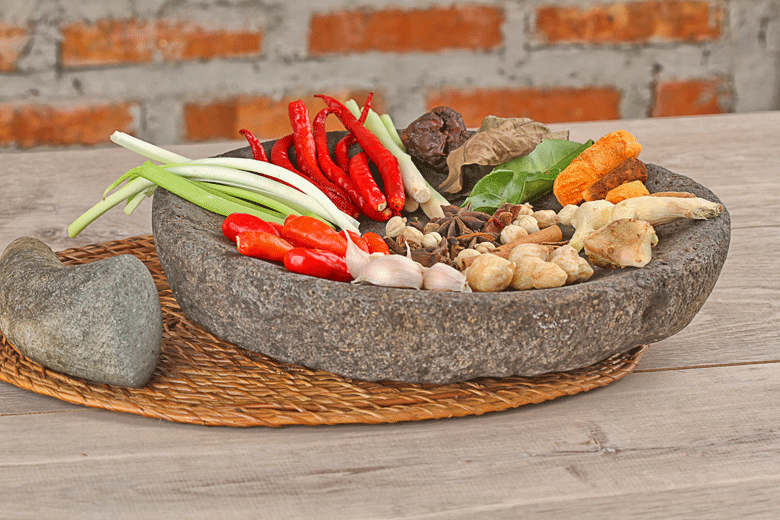
Coconut flavoured rice with Dried Anchovy Sambal
Author: Ceegee
Nutrition Information
- Serving size: 100g
- Calories: 106 kcal
- Fat: 7.8 grams
- Saturated fat: 2.7 grams
- Carbohydrates: 3.3 grams
- Sugar: 3.2 grams
- Sodium: 0.21 grams
- Fiber: 0.6 grams
- Protein: 6 grams
Recipe type: Flavoured rice
Cuisine: Indonesia
Prep time:
Cook time:
Total time:

This recipe is a typical combination of the sweet, sour, salty and pungent flavours that are popular in Indonesia. From a country that loves its Chillies,in this great tasting recipe , coconut flavoured rice is topped with Sambal Ikan Bilis (Dried Anchovies Sambal) and other accompaniments . Believe it or not, but this is usually a breakfast dish in that part of the world, but don’t let that sway you. It is fantastic whatever time of the day it is eaten
Ingredients
For the rice
- Rice - two cups Basmati or similar
- Pandan leaves - three (see note*)
- Salt to taste
- Coconut milk - one can (400ml)
- White onion – one medium (finely chopped)
- Vegetable oil – one teaspoon
For the Sambal Ikan Bilis
- Red onion – one finely sliced
- Vegetable oil – one tablespoon
- Dried anchovies – one cup (see note**)
- Garlic – one clove
- Shallots – four (coarsely chopped)
- Dried chillies (see note)
- Shrimp paste – one teaspoon ( see note ***)
- Sugar - 1 tablespoon sugar
- Juice of one lime (see note ****)
- One cup of water
Other ingredients
- Hard-boiled eggs - two cut into half
- Dried anchovies - two handfuls ( see cooking instructions below)
- Vegetable oil for deep-frying anchovies (dependant on the size of pan/pot)
- Roasted peanuts
- Cucumber – one small ( sliced)
Instructions
For the rice
- Place rice in a colander or sieve and run under cold water to release some of the starch (the water will run clear once this achieved. Drain and keep to one side
- Pour oil into a pot (big enough for the volume of rice that will be made). Bring oil to a medium heat
- Add the onions and fry until translucent
- Add the rice and cook for a minute or two
- Add the coconut milk, the Pandan leaves, salt and a little water. Bring to a simmer, stirring continuously
- Turn down the heat to low heat and then cover the pot with a lid
- Check the rice intermittently and scrape the bottom of the pot with a wooden spoon to ensure that it is not sticking
- Once the rice is cooked remove from the stove and keep warm
For the deep-fried anchovy accompaniment
- Deep fry in oil for five minutes until crispy,. Drain and keep aside
To make the sambal
- Rinse and drain the anchovies. Using a little vegetable oil, fry the fish until slightly browned. Keep to one side
- Place the shrimp paste, chillies, garlic and shallots in a food processor or blender with a little water. Pulse until combined into a paste
- Place one tablespoon of vegetable oil in a pan and bring to medium heat. Add red onions and fry gently for two minutes. Add the fried anchovies
- Now add the shrimp paste mix from above. Stir, allowing onions and paste to combine
- Add the lemon juice, water and sugar. (if using tamarind juice, omit water and lemon juice) Stir until the sauce has thickened. Set aside. Keep warm
And finally
- To serve spoon rice onto a plate, add sambal and top with dried anchovies, shelled peanuts, eggs and cucumbers
Notes
This dish can be served on its own or as part of of a larger plate, It is sometimes combined with fried fish, chicken or beef
Any red chillies can be used for this recipe, but consider you are looking for a bit of heat. Consider Cayenne or Birds-eye type. As always, adjust to personal heat tolerance
*Pandang leaves provide significant flavour to this dish. Without them, it would certainly be lacking something. They can be bought online
**The Indonesian word for dried anchovies is Ikan Bilis. It can easily be found online using this term
*** Shrimp paste can be found online using the names “ Terasi”, “ Belacan.” or “ Kapi”
**** Authentic Nasi Lemak uses Tamarind juice. If you have this on hand, substitute it for the lime juice and the water
Keywords: Nasi Lemak
Serves: 4 portions
Any red chillies can be used for this recipe, but consider you are looking for a bit of heat. Consider Cayenne or Birds-eye type. As always, adjust to personal heat tolerance
*Pandang leaves provide significant flavour to this dish. Without them, it would certainly be lacking something. They can be bought online
**The Indonesian word for dried anchovies is Ikan Bilis. It can easily be found online using this term
*** Shrimp paste can be found online using the names “ Terasi”, “ Belacan.” or “ Kapi”
**** Authentic Nasi Lemak uses Tamarind juice. If you have this on hand, substitute it for the lime juice and the water
Keywords: Nasi Lemak
Serves: 4 portions
